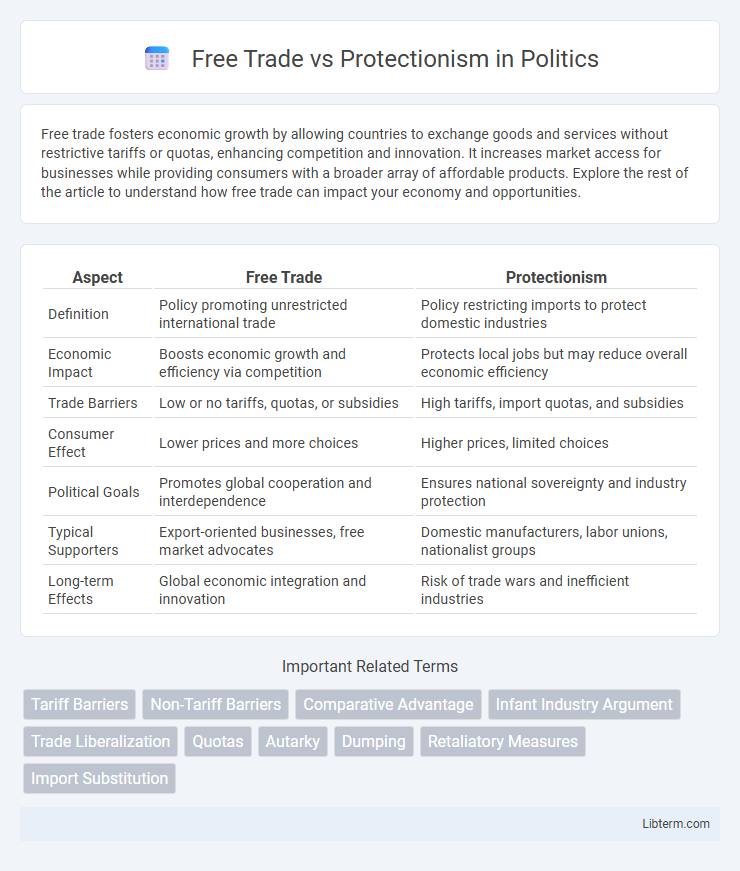Free trade fosters economic growth by allowing countries to exchange goods and services without restrictive tariffs or quotas, enhancing competition and innovation. It increases market access for businesses while providing consumers with a broader array of affordable products. Explore the rest of the article to understand how free trade can impact your economy and opportunities.
Table of Comparison
| Aspect | Free Trade | Protectionism |
|---|---|---|
| Definition | Policy promoting unrestricted international trade | Policy restricting imports to protect domestic industries |
| Economic Impact | Boosts economic growth and efficiency via competition | Protects local jobs but may reduce overall economic efficiency |
| Trade Barriers | Low or no tariffs, quotas, or subsidies | High tariffs, import quotas, and subsidies |
| Consumer Effect | Lower prices and more choices | Higher prices, limited choices |
| Political Goals | Promotes global cooperation and interdependence | Ensures national sovereignty and industry protection |
| Typical Supporters | Export-oriented businesses, free market advocates | Domestic manufacturers, labor unions, nationalist groups |
| Long-term Effects | Global economic integration and innovation | Risk of trade wars and inefficient industries |
Introduction to Free Trade and Protectionism
Free trade promotes the unrestricted exchange of goods and services across borders, fostering economic growth by allowing countries to specialize based on comparative advantage. Protectionism involves government policies such as tariffs, quotas, and subsidies designed to shield domestic industries from foreign competition. Balancing free trade and protectionism impacts global markets, influencing consumer prices, employment, and international relations.
Historical Overview of Trade Policies
Trade policies have evolved significantly from mercantilism in the 16th century, emphasizing tariffs and colonial monopolies, to the 19th century's classical liberalism advocating free trade through agreements such as the Cobden-Chevalier Treaty. The 20th century witnessed a shift with the establishment of institutions like the General Agreement on Tariffs and Trade (GATT) and later the World Trade Organization (WTO), promoting trade liberalization while grappling with protectionist measures during economic crises. Historical episodes, including the Smoot-Hawley Tariff Act of 1930 and post-World War II reconstruction, highlight the ongoing tension and balance between free trade principles and protectionist policies aimed at safeguarding domestic industries.
Key Principles of Free Trade
Free trade is founded on the principle of comparative advantage, allowing countries to specialize in producing goods and services where they have lower opportunity costs, leading to increased efficiency and higher global output. It promotes open markets with minimal tariffs, quotas, and trade barriers to facilitate the free flow of goods, services, and capital across borders. Emphasizing competition and innovation, free trade aims to lower prices for consumers, enhance product quality, and foster economic growth worldwide.
Key Principles of Protectionism
Protectionism centers on key principles such as imposing tariffs, quotas, and import restrictions to shield domestic industries from foreign competition. Governments use these trade barriers to preserve local jobs, promote economic self-sufficiency, and protect emerging sectors from international market fluctuations. This approach often prioritizes national economic interests over global trade liberalization to maintain sovereignty and economic stability.
Economic Benefits of Free Trade
Free trade enhances economic growth by allowing countries to specialize in producing goods where they have a comparative advantage, leading to increased efficiency and productivity. It fosters competition and innovation, driving down prices and expanding consumer choices globally. Access to larger markets also attracts foreign investment, boosting employment and technological advancement in participating economies.
Economic Advantages of Protectionism
Protectionism boosts domestic industries by shielding them from foreign competition through tariffs, quotas, and subsidies, preserving local jobs and promoting economic stability. It fosters the growth of nascent industries, allowing them to develop and become competitive internationally over time. Governments use protectionist policies to maintain national security by safeguarding critical sectors and reducing dependency on imports.
Impact on Domestic Industries
Free trade allows domestic industries to access larger markets and benefit from economies of scale, enhancing innovation and competitiveness. Protectionism shields local businesses from foreign competition through tariffs and quotas, which can preserve jobs but may lead to inefficiency and higher consumer prices. The balance between these approaches affects industry growth, with free trade promoting export expansion while protectionism supports short-term industry stability.
Effects on Consumer Choice and Prices
Free trade expands consumer choice by allowing access to a wider variety of goods and services from global markets, often resulting in competitive prices due to increased supply. Protectionism, through tariffs and import restrictions, limits product availability and typically drives prices higher by reducing competition and increasing production costs. Economic studies confirm that consumers generally benefit from lower prices and greater diversity of options under free trade policies compared to protectionist measures.
Global Trade Agreements and Disputes
Global trade agreements such as the World Trade Organization (WTO) and regional pacts like the USMCA facilitate free trade by reducing tariffs and standardizing regulations, promoting economic growth and market access. Protectionism, characterized by tariffs and quotas, often leads to trade disputes, with parties invoking mechanisms within agreements like the WTO dispute settlement system to resolve conflicts. These disputes highlight underlying tensions between national interests and global trade liberalization, affecting international economic relations and policy decisions.
Future Outlook: Balancing Free Trade and Protectionism
Balancing free trade and protectionism requires adaptive policies that promote economic growth while safeguarding domestic industries against global market volatility. Emerging technologies and shifting geopolitical dynamics will shape future trade frameworks, emphasizing strategic partnerships and sustainable practices. Policymakers must design flexible trade regulations that foster innovation and competitiveness without compromising national economic security.
Free Trade Infographic

 libterm.com
libterm.com